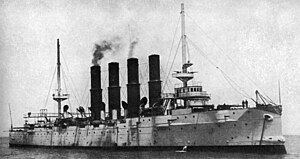Russian cruiser Varyag (1899)

| |
| History | |
|---|---|
| Name | Varyag |
| Builder | William Cramp and Sons, Philadelphia |
| Laid down | October 1898 |
| Launched | 31 October 1899 |
| Commissioned | 2 January 1901 |
| Fate | Scuttled 9 February 1904 |
| History | |
| Name | Soya |
| Acquired | by Japan as prize of war |
| Commissioned | 9 July 1907 |
| Fate | Returned to Russia, 5 April 1916 |
| History | |
| Name | Varyag |
| Acquired | 5 April 1916 |
| Fate | Ran aground 1920, sank 1925 |
| General characteristics | |
| Type | Protected cruiser |
| Displacement | 6,500 long tons (6,604 t) |
| Length | 129.6 m (425 ft 2 in) w/l |
| Beam | 15.8 m (51 ft 10 in) |
| Draught | 6.3 m (20 ft 8 in) |
| Speed | 23 knots (26 mph; 43 km/h) |
| Complement | 570 |
| Armament | list error: <br /> list (help) • 13 × 265 mm (10 in) guns • 13 × 129 mm (5.1 in) guns • 10 × 79 mm (3.1 in) guns • 9 × torpedo tubes |
Varyag (also spelled Variag; see Varangian for the meaning of the name) (Russian: кре́йсер «Варя́г») was a Russian protected cruiser that is well-known in the military history of Russia. The Imperial Admiralty contracted William Cramp and Sons of Philadelphia, Pennsylvania to build the ship, and her keel was laid in October 1898. Launched on October 31, 1899, under Captain Vladimir Behr, she was commissioned into the Imperial Russian Navy on January 2, 1901.

During her construction, an assistant physician, Leo Alexandroff, left the ship's advance party on April 20, 1899, and applied for U.S. citizenship. He was arrested for desertion. His case reached the United States Supreme Court, which ruled in Tucker v. Alexandroff that the ship, though not accepted for service in the Imperial Russian Navy, was a warship under the terms of the 1832 treaty between Russia and the United States.[1]
During the Battle of Chemulpo Bay at the start of the Russo-Japanese War, Varyag (under the command of Captain of the First Rank Vsevolod Rudnev) accepted a badly unequal battle with the Japanese squadron of Admiral Uriu (one armoured cruiser, five protected cruisers and eight destroyers) in a heroic attempt to break out from Chemulpo (Incheon) harbour February 9, 1904. Chemulpo was in neutral Korean waters. Admiral Uriu gave the Russian ships in harbor an written ultimatum to sail by 12:00 noon or be attacked in the harbor itself. Captain Rudnev sortied, accompanied by the gunboat Koreets; having lost 31 men dead, 191 injured (out of 570) and outgunned, both ships returned to harbor by 1:00 p.m., the crew decided not to surrender, but to sink the ship. The crew was saved by transferring them to the British cruiser Talbot, the French cruiser Pascal, and the Italian cruiser Elba; the captain of the American cruiser Vicksburg declined doing so as a violation of U.S. neutrality. [2][3]
In 1907, Vsevolod Rudnev (by that time dismissed in the rank of rear admiral) was decorated with a Japanese order for that battle; although he accepted the order, he never wore it in public.
The Varyag was later salvaged by the Japanese and repaired. She served with the Imperial Japanese Navy as light cruiser Soya.
During World War I, Russia and Japan were allies and several ships were transferred by the Japanese to the Russians. She was returned to the Imperial Russian Navy at Vladivostok on April 5, 1916 and renamed Varyag. She was sent to Great Britain for an overhaul, and was due to re-enter service with the Arctic squadron of the Russian Navy. However, following the Russian October Revolution on November 7, 1917 she was seized by the British and sold to Germany in 1920 for scrap. That same year, while under tow in the Firth of Clyde, she ran aground on rocks near the Scottish village of Lendalfoot, and was scrapped there (55°11′03″N 04°56′30″W / 55.18417°N 4.94167°W). She finally sank in 1925 and was never recovered.
On Sunday July 30, 2006 (Russian Navy Day), a monument to the cruiser was unveiled at Lendalfoot in a ceremony attended by senior Russian politicians and navy personnel, veterans and local dignitaries.[4]
On 8th September 2007 a large bronze memorial was dedicated at Lendalfoot.

References
- ^ Tucker v. Alexandroff, 183 U.S. 424.
- ^ Report from Robert S. McCormack to Secretary of State John Hay, May 11, 1904, in Papers Relating to the Foreign Relations of the United States, 1904, Government Printing House, Washington
- ^ Resting place of Russian cruiser Varyag South Ayrshire Council News
External links
- Complements of "Varyag" & "Koreets" (posts, birth places & dates, posterior fortune) Template:Ru icon
- The memory of "Varyag" will be perpetuated in Great Britain Template:Ru icon
- Russian News and Information Agency article British monument to Russian glory
- "Cruiser 'Varyag'" Fund
- Cruiser "Varyag". Legends. Myths. Facts Template:Ru icon
- Photograph of Varyag Memorial
